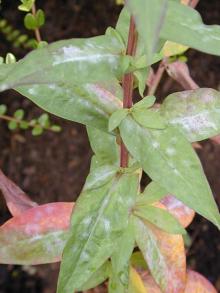Cause Golovinomyces asterum var. asterum (formerly Erysiphe cichoracearum), a fungus that overwinters in plant debris such as old stems and leaves. This fungus is favored by conditions that produce high humidity but dry leaves. The Podosphaera xanthii complex has also been reported worldwide. These fungi are favored by conditions that produce high humidity but dry leaves. They are highly specialized pathogen that forms a close association with the host. Conditions that favor the host also favor the pathogen. Much of the fungus remains outside infected plant parts where it grows on the surface but sinks root-like structures called haustoria into plant cells to obtain nutrients. The white growth seen is composed of both mycelium and fungal spores.
Symptoms Powdery white or gray-white fungus growth on leaves and stems of aster. On some plants, a purplish discoloration and leaf distortion may occur.
Cultural control
- Keep humidity to a minimum.
- Avoid wetting foliage.
- Remove affected plant parts during the growing season.
- Remove and destroy plant debris in the fall.
Chemical control Begin applications when disease first appears and repeat every 10 to 14 days to protect foliage. Regular scouting will ensure disease detection early enough to make chemical management effective. Alternate or tank-mix products from different groups that have different modes of action.
- Armada 50 WDG at 3 to 9 oz/100 gal water. Do not use a silicone-based surfactant. Not for nursery or greenhouse use. Group 3 + 11 fungicide. 12-hr reentry.
- Bicarbonate-based products (85% potassium bicarbonate). Might supplement a normal program when powdery mildew is first observed. Do not mix with acidifying agents. Thorough coverage is essential. O
- MilStop at 2.5 to 5 lb/A in the field or 1.25 to 5 lb/100 gal water in the greenhouse. Oregon and Washington only. 1-hr reentry.
- Compass 50 WDG at 1 to 2 oz/100 gal water. Do not use organosilicate additives. Group 11 fungicide. 12-hr reentry.
- Eagle 20 EW at 6 to 12 fl oz/100 gal water. Group 3 fungicide. 24-hr reentry.
- Heritage at 1 to 4 oz/100 gal water plus a non-silicone-based wetter sticker. Group 11 fungicide. 4-hr reentry.
- Myclobutanil 20 EW T&O at 6 to 12 fl oz/100 gal water plus spreading agent. May observe a PGR effect. Group 3 fungicide. 24-hr reentry.
- Ortho Rose & Flower Disease Control at 2 fl oz/gal water. Group 3 fungicide. H
- Seido at 4 to 5 fl oz/100 gal water plus an adjuvant. Group 50 fungicide. 4-hr reentry.
- Spectracide Immunox Multi-Purpose Fungicide Spray Concentrate for Gardens at 1 fl oz/gal water. Group 3 fungicide. H
- Sulfur-based products. Do not use when temperature is over 85°F or within a few weeks of an oil spray. Group M2 fungicides. 24-hr reentry. O
- Safer Brand Garden Fungicide (Ready To Use 0.4% sulfur) thoroughly sprayed over the entire plant. H
- Thiolux (80% sulfur) at 3 to 10 lb/A.
- Terraguard SC at 4 to 8 fl oz/100 gal water. Group 3 fungicide. 12-hr reentry.
Biological control
- Cease or Rhapsody (Bacillus subtilis strain QST 713) at 2 to 8 quarts/100 gal water. Active ingredient is a small protein. Efficacy in the Pacific Northwest is unknown. 4-hr reentry. O
Reference Braun, U. and Cook, R.T.A. 2012. Taxonomic Manual of the Erysiphales (Powdery Mildews). CBS-KNAW Fungal Biodiversity Center, The Netherlands.


